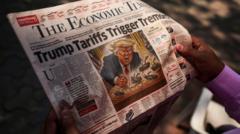A recent report indicates that out of India's 1.4 billion population, approximately one billion lack discretionary spending power, reflecting deepening economic disparities. While the affluent segment expands through premiumisation trends, the middle class struggles with stagnating incomes and increased financial pressures, raising concerns about long-term consumer demand and economic growth.
A Billion Indians Struggle with Spending Power: Analysis of Economic Disparities

A Billion Indians Struggle with Spending Power: Analysis of Economic Disparities
A startling report reveals that a billion Indians are unable to spend on discretionary goods, highlighting stark economic inequalities and consumption trends in the country.
A recent analysis highlights a considerable economic challenge facing India, revealing that approximately one billion of its 1.4 billion citizens lack sufficient disposable income for discretionary spending. This report, published by Blume Ventures, a venture capital firm, sheds light on the stark divisions within the country's consumer landscape. The core of India's consuming class consists of about 130 to 140 million individuals, roughly equivalent to the population of Mexico, while an additional 300 million people are categorized as "emerging" or "aspirant" consumers, who are hesitant spenders beginning to engage more with digital transactions.
The findings suggest that instead of expanding, the consuming class in India is "deepening," illustrating a situation where wealth is becoming increasingly concentrated among the rich, rather than forming a broader base of wealth. Reports indicate that while the affluent continue to accumulate wealth, the overall number of wealthy individuals has not seen significant growth. This trend is contributing to a noticeable shift towards "premiumisation," where companies focus on expanding the availability of higher-priced products, forsaking the mass-market offerings that traditionally appealed to the middle class.
This growing premiumisation is evidenced by the rise in sales of luxury goods, upscale real estate, and high-ticket experiences like concerts featuring international artists. Conversely, affordable housing, which once constituted nearly 40% of India's market, has plummeted to just 18%. Companies that have aligned with this new consumer behavior have found growth opportunities, while those concentrated on mass-market products have struggled to maintain relevance.
This dynamic has raised concerns about the “K-shaped recovery” following the pandemic, where the affluent have rebounded significantly while the lower-income demographic has lost ground. Evidence suggests that economic inequality in India has been on the rise for decades, with income generated by the wealthiest 10% soaring from 34% in 1990 to nearly 58% today. Conversely, the lower half of the population now holds only a fraction of national income, a decrease from 22% to 15%.
Moreover, the current landscape is exacerbated by a decline in purchasing power, falling financial savings, and rising debt levels among lower and middle-income groups. Regulatory actions by the Reserve Bank of India (RBI) have curtailed easy access to unsecured loans that previously bolstered consumption among aspiring consumers. While immediate measures, such as a forecasted uptick in rural spending from a record harvest and a recent tax cut worth $12 billion, may provide some relief, the overarching economic pressures remain formidable.
Looking to the future, the middle class, historically a driver of consumer demand, is under significant pressure. Reports indicate stagnating wages over the past decade for the middle 50% of the tax-paying population, leading to a concerning decline in their real income. This decline contributes to an alarming state of savings, with households' net financial savings nearing a 50-year low.
Notably, as technology advances—including the rise of artificial intelligence automating numerous jobs—the prospect of job displacement poses a risk to the traditional employment landscape, particularly in urban areas. A recent government economic survey points to the potential macroeconomic ramifications of this trend, indicating that lost consumer spending due to workforce disruption could threaten the nation's economic trajectory moving forward. The findings encapsulate a deeply entrenched issue: the struggle for a significant segment of the Indian population to achieve sustainable economic stability amidst shifting market dynamics.






















